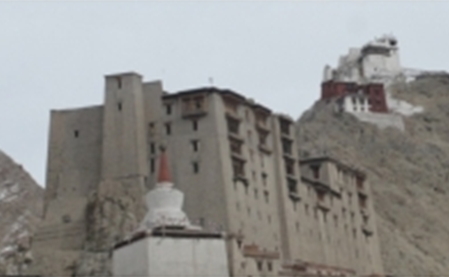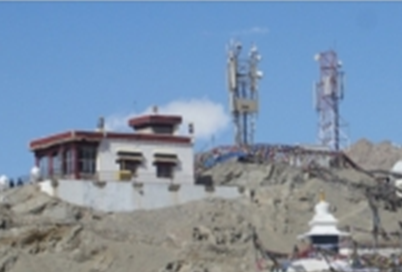Ladakh: Heritage
This is a collection of articles archived for the excellence of their content. Readers will be able to edit existing articles and post new articles directly |
Landscape Heritage
The ruining of the landscape
The awesome natural landscape is not only to cherish, but respected too By Tashi Leh, Saturday, April 6, 2013
Leh: Ladakh is a place close to upper limit of human civilization in the Himalayas. And there is no doubt it has many important power-points; dwelling place of intangible elements - in the mountains, lakes, streams, passes, caves, junipers etc. Spirits, demons or gods of powerful sites may harm or help travelers, so it is said. We have examples where masters have been performing meditations on holy sites throughout Himalayas. Such retreats have always been penetrated into deep valleys in the mountains. I surely believe, construction of various monasteries, forts, castles, chortens etc. are placed on such holy or powerful sites.
It is also said that the interaction between the life forces (bla) and the space (gnas) together may become power-place, often called sten (abode of a deity). We are in no dearth of such places in Ladakh. There are obvious spiritual or religious reasons.
The nature has in fact played a timeless effort in creating the beauty in the natural landscape, which is what we are proud of today and which is also a major tourist attraction too. Humans have played an important role in altering this natural landscape. For quite long time this change was aesthetic with spiritual consciousness and with due respect to the lha and lhu.
Today, what I see is marks and bleaches on the ‘moonland’ with filthy craters of all kind and shapes. The landscape as if being drained and getting devoid of any order. I know it is an economic driven market, but do we deprogram our belief or the aesthetic sense? And most of all can’t the two go together?
Let me give you a few examples of landscape ruining: The towers on the ‘Kiu-tak’ not only spoiled the aesthetic view of the hill, but I also believe it must have spoiled the sanctity of the hill. The first view of Wanla gonpa when coming from Lamayuru trek is now shadowed with a huge metal tower in the foreground. So is the tower behind Stok palace. Tower of all sorts are an inevitable elements of development, but can’t it be done less damagingly to the landscape heritage?
The building of Cafeteria at the ‘Sangam’ bank ruined my view of the confluence from the top. It was one of the most photographed sites of a spectacular natural view. The two holy rivers have a cafeteria with urinals on their bank now.
The building of water tank (I suppose) at the ridge of Tsemo and on the roadside of the ‘Jewe tsal’ sanctuary was not only a view spoiling construction, but it could have been easily avoided with many other alternatives. The shabby tiny ‘match-boxes’ along the Taru Thang is absolutely out of sync with the landscape.
The digging of road sides like at ‘Tyaray Rong’, Shey sand on the road side behind the Khar, Markalak of Spituk are signs of chaotic order of the otherwise beautiful landscape.
The tin-sheeted shabby colonies suddenly appearing in a beautiful desolated valley is a common scene. The left over by-product of road and other construction along the road is a sore. The dangling wires all around the town reflect as if it has been webbed by some Spiderman.
Cultural heritage
Pre-historic camping site, in Nubra valley

The Hindu, December 4, 2016
T.S. Subramanian
Pre-historic camping site found in Ladakh
A camping site dating back to 8500 BCE in the Nubra Valley in Ladakh.
In what is considered “a new opening in Indian archaeology”, an ancient camping site used by pre-historic man and datable to circa 8500 BCE, has been found at an altitude of about 4,200 metres near Saser La in the Nubra Valley, Ladakh. Saser La leads to the Karakoram Pass.
A camping site is a place where hunter-gatherers stayed temporarily before they moved on to another place. S.B. Ota, Joint Director General, Archaeological Survey of India (ASI), found the camping site during an exploration there in 2015-16. Charcoal pieces from hearth activity and remains of bones associated with it were found at the site. The charcoal pieces sent for dating to Beta Analytic, Florida, U.S., revealed that the site belonged to circa 8500 BCE.
Rakesh Tewari, Director General, ASI, called it “the earliest camping site in Ladakh”. He told The Hindu, “Such an early antiquity on the basis of a scientific date is the very first for that region. This date has generated a lot of in-house discussion and excitement in the ASI.”
Dr. Tewari, who visited the site in July 2016, explained that “a camping site” is “a seasonal settlement, not a permanent settlement.” The camping site found near Saser La was “an ideal place for camping in a picturesque setting,” he said. He described it as “a flat area of barren land with loose rocks all around, snow-covered peaks at a distance and a stream” in a gorge.
Ladakh is famous for its Himalayan mountain ranges, its spectacular glaciers, passes, valleys and the Buddhist monasteries. But not much archaeological importance was attached to the region.
‘Remarkable discovery’
Only 6th century CE to 7th century CE remains were reported in Ladakh. Rough terrain, high altitudes and extreme weather made it difficult for any explorer to undertake archaeological expeditions in the region.
However, the arduous and persistent efforts made by an ASI team under Dr. Ota led to “remarkable archaeological discoveries in Ladakh,” the ASI Director-General added

